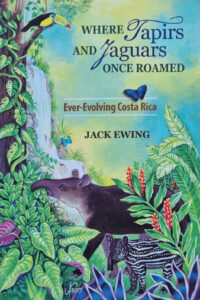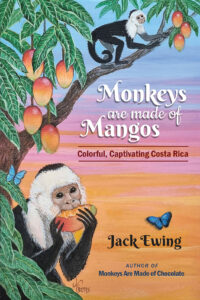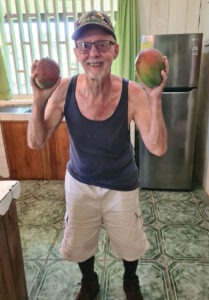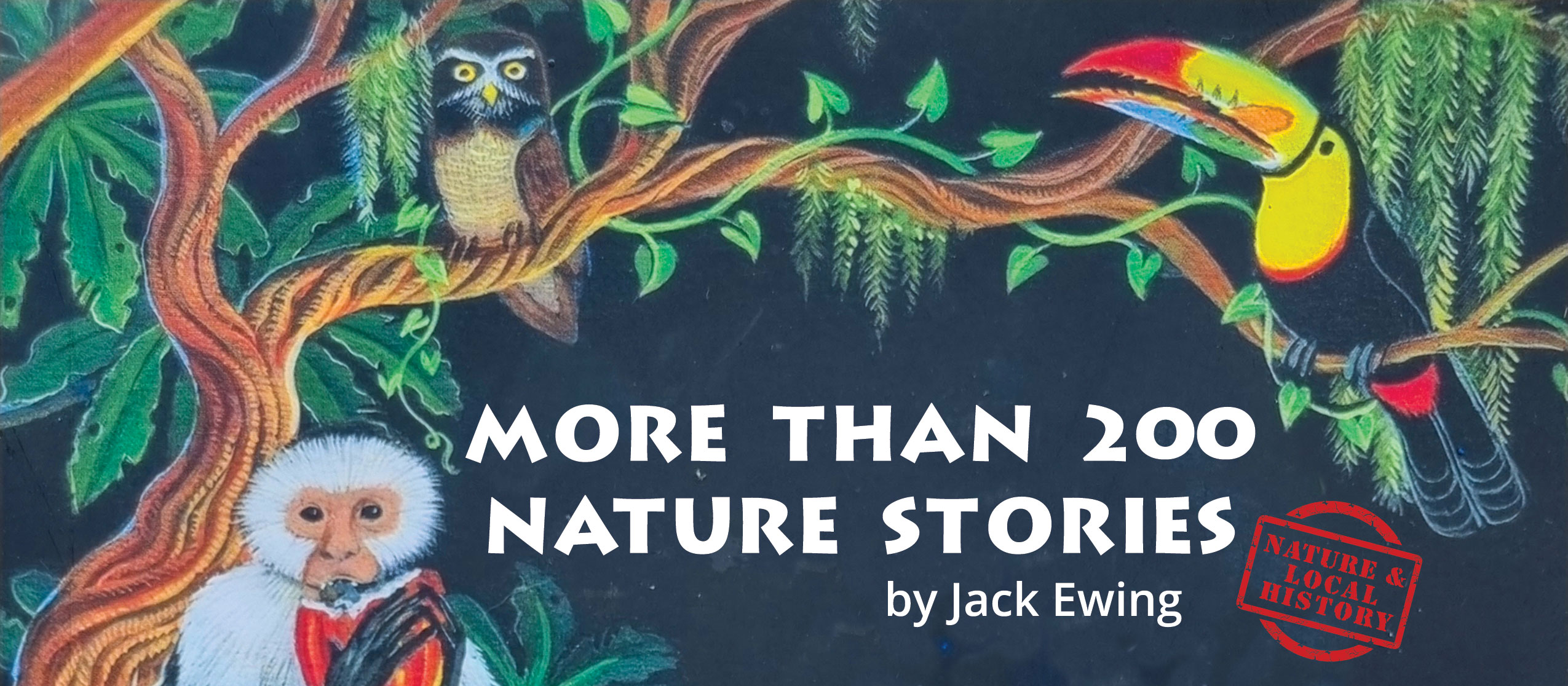More Than 200 Nature Stories
 I don’t remember when I wrote my first article for Quepolandia, but my first book, Monkeys Are Made of Chocolate, was a collection of 32 articles, most of which had been previously published in Quepolandia. The first edition of the book was published in Costa Rica in 2003. That means I probably began writing the articles in 1999 or 2000, and that I have written more than 200 articles for the magazine beginning with Ana Lyons as owner and publisher, followed by Pat Cheek, and now Dave Bolger, all of them first class editors and publishers. Graphic artist, Paul Rees, joined the magazine a couple of months before Ana sold it to Pat. He says that he got sold with the magazine every time it changed hands. Paul works his special magic on each issue and puts everything together for publishing. The owners’ jobs would have been much more difficult without him.
I don’t remember when I wrote my first article for Quepolandia, but my first book, Monkeys Are Made of Chocolate, was a collection of 32 articles, most of which had been previously published in Quepolandia. The first edition of the book was published in Costa Rica in 2003. That means I probably began writing the articles in 1999 or 2000, and that I have written more than 200 articles for the magazine beginning with Ana Lyons as owner and publisher, followed by Pat Cheek, and now Dave Bolger, all of them first class editors and publishers. Graphic artist, Paul Rees, joined the magazine a couple of months before Ana sold it to Pat. He says that he got sold with the magazine every time it changed hands. Paul works his special magic on each issue and puts everything together for publishing. The owners’ jobs would have been much more difficult without him.
I believe it was Ana Lyons who first suggested that I publish a collection of articles. That idea grew and matured into my first book, Monkeys Are Made of Chocolate, published by PixyJack Press, 32 chapters, most having previously appeared in Quepolandia, each one a nature story and most from my own personal experience.
 Over the last 23 years I have had a few computer mishaps and lost a couple of hard discs, so I don’t have a copy of that first article, but I remember that it was about biological corridors, what they are, and why they’re important. Rewilding of the area along the coast south of the Los Santos Reserve and the Savegre River, thus connecting more than 20 biodiverse nature reserves, resulted in the creation of the Path of the Tapir Biological Corridor, today one of the best-known corridors in the country.
Over the last 23 years I have had a few computer mishaps and lost a couple of hard discs, so I don’t have a copy of that first article, but I remember that it was about biological corridors, what they are, and why they’re important. Rewilding of the area along the coast south of the Los Santos Reserve and the Savegre River, thus connecting more than 20 biodiverse nature reserves, resulted in the creation of the Path of the Tapir Biological Corridor, today one of the best-known corridors in the country.
Since the mid-1990s I had pondered writing a short history of the area, but as I searched for information there was little to be found. I realized that if I didn’t dig it up, put it together, and write it down myself, the story would be forgotten and lost to future generations. I went to work. Every now and then a new chapter was published in Quepolandia until 2015 when Where Tapirs and Jaguars Once Roamed was complete.
 The Path of the Tapir is one of the few places in the world where biodiversity is increasing. Pumas, three species of monkeys, scarlet macaws, Montezuma oropendolas, green ibis, crested guans, and rufous-necked wrens are a few of the species that have returned to the area by way of the corridor. Other rare and beautiful species have increased in population. The book tells the story beginning with the geological formation of Central America, the migration of indigenous tribes into the area, the stories of the first pioneers who deforested the area for the production of cattle and crops, and the changes that have taken place during the years that I have lived here. I am currently translating the book into Spanish.
The Path of the Tapir is one of the few places in the world where biodiversity is increasing. Pumas, three species of monkeys, scarlet macaws, Montezuma oropendolas, green ibis, crested guans, and rufous-necked wrens are a few of the species that have returned to the area by way of the corridor. Other rare and beautiful species have increased in population. The book tells the story beginning with the geological formation of Central America, the migration of indigenous tribes into the area, the stories of the first pioneers who deforested the area for the production of cattle and crops, and the changes that have taken place during the years that I have lived here. I am currently translating the book into Spanish.
One afternoon I was out for a walk hoping to find a couple of mangos for breakfast the following morning. To my surprise and delight the tree where I hoped to find the mangos was full of monkeys. It was the first time I had seen monkeys in that location. They had come across a corridor of young trees that were barely big enough for the monkeys to travel across them. Typical of the wasteful behavior of white-fronted capuchins they would grab a mango, take a bite or two and throw the rest on the ground. I walked under the tree to try to find a whole one and was bombarded with mangos, thrown by the monkeys. I managed to find two big, beautiful mangos and escape unscathed. Returning home, I showed the mangos to Diane and told her the story. “There you go”, she smiled, “another book, Monkeys Are Made of Mangos”. I presented the idea to the owner of PixyJack Press, she loved it, and the book will be available soon, perhaps by the end of 2023.
I have a good start on another book entitled The Nature of Mother Nature. Rather than explain what it is about, here is a sneak preview, an excerpt from the first chapter:
“Mother Nature is not only a nurturer but also a destroyer. The explosion of the volcano Krakatau in Indonesia is a perfect example of the extreme cataclysmic force that Mother Nature is capable of setting into motion when it serves Her purposes.
Krakatau, once a volcanic island of about 80 square kilometers, exploded on August 27, 1883, with a force equal to approximately 150 megatons of TNT. To help make sense of those big numbers let’s look at the first atom bomb ever deployed, which was exploded over Hiroshima, Japan on August 25, 1945. In that blast 80,000 people died instantly, but the Hiroshima bomb was only 15 kilotons, one ten-thousandth as big as the eruption of Krakatau. Around 20 cubic kilometers (8,300 times the volume of the Houston Astrodome) of tephra (the stuff that volcanoes blast up into our atmosphere) were thrown five times as high as a commercial airliner normally flies. The sound was heard as far away as the distance between New York and Los Angeles. The explosion and accompanying seismic activity created a tsunami that killed about 36,000 people in the surrounding lands. So much sulfur dioxide was ejected into the atmosphere that it reduced the amount of sunlight reaching the surface of the earth and the average global temperature dropped by 1.2 degrees Celsius for five years. The volcano and most of the rest of the island sank into the sea, leaving a crater seven kilometers in diameter. Rakata, which had been a mountain on the far end of the island, about 20 kilometers from the volcano, was the only remaining feature of the island. It was sterile and devoid of life. After this act of total destruction, Mother Nature put her creative talents to work. One-hundred years later Rakata was a lush tropical paradise”.
 That will give you an idea of Mother Nature’s capabilities and what she does when it suits her purposes.
That will give you an idea of Mother Nature’s capabilities and what she does when it suits her purposes.
Congratulations to Quepolandia on its 25th anniversary and thank you to all the people who made it the great success that it is.
Jack Ewing was born and educated in Colorado. In 1970 he and his wife Diane moved to the jungles of Costa Rica where they raised two children, Natalie and Chris. A newfound fascination with the rainforest was responsible for his transformation from cattle rancher into environmentalist and naturalist. His many years of living in the rainforest have rendered a multitude of personal experiences, many of which are recounted in his published collection of essays, Monkeys are Made of Chocolate. His latest book is, Where Jaguars & Tapirs Once Roamed: Ever-evolving Costa Rica.

